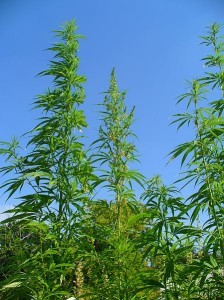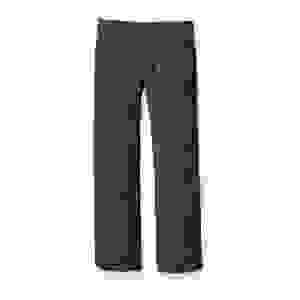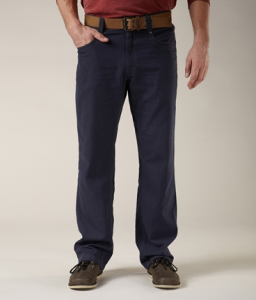
For the vast majority of reasonable humans found anywhere on the planet, jeans are the greatest invention in the medium of apparel in the history of human civilization. They look good. They feel good. They are suitable for (nearly) any social occasion. The good ones last forever. And they’re popular enough that you can find them in specifications that will adhere to your body in exquisite fashion. Pun intended.
On the downside, they’re hot, heavy, and take forever to dry. The heat is only a problem in the summer, of course, and drying time is of no concern to people with laundry facilities. But why are we still wearing hot and heavy denim jeans when a million different fabrics brag about spectacular temperature regulation and moisture management?
Cotton denim jean alternatives
The outdoor industry has been blathering on and on about performance fabrics for decades now, and with good reason. Cotton is a horrific fabric, particularly in terms of environmental sustainability, but has a number of comfort disadvantages as well, particularly when it comes to extreme weather conditions. They’ve come up with a million different solutions that work a million times better, yet somehow no one bothers using them in a pair of jeans.

I’ve complained rather ferociously about the inexcusable crime against humanity that is the world’s lack of travel jeans, and every year I look for alternatives with practically nothing in sight. It’s a Sisyphean hamster wheel on which I run continuously, all the while thinking in the back of my head that I could just buy the damn fabric and learn to sew for myself in the amount of time it’ll take for the gargantuan sloth that is the clothing industry to embrace new technologies and implement them on a readily-available scale.
So I’d like to direct today’s rage at one particular solution that would be absolutely spectacular, but which almost nobody bothers exploiting:
Hemp jeans
Turns out the hippies were right. Hemp is an absolutely spectacular fabric for jeans, and a variety of other things, and we don’t bother using it because we’re all stupid.
Hemp promises a number of advantages, both in terms of performance and sustainability, which will make you wonder why we’ve been using cotton this whole time.
- Durability. Hemp was used to make ropes for ships, because it was incredibly strong. It’s quadruple the strength of cotton, so it’ll outlast your current jeans by decades.
- Moisture management. Hemp feels a lot like linen, transporting moisture away from the skin and avoiding that sticky, clingy feeling on hot days.
- Temperature regulation. Hemp will paradoxically keep you warmer in winter, and cooler in summer.
- Natural odor resistance. You know how jeans are famous for never being washed? Well, hemp will let you get away with this even more.
- Soft and comfy. It doesn’t have that tough texture like cotton denim. It’s kind of silky.
On top of all that, it’s important to point out the myriad advantages of hemp in terms of environmental sustainability. If you haven’t heard, cotton is a horrific fabric for the environment. Hemp is not only more comfy, but it’s also better for everyone involved:
- Land use: Cotton needs twice as much land as hemp.
- Water use: Cotton needs about 4 times as much water as hemp.
- Pesticides: Cotton production tends to involve a ridiculous amount of pesticides, and those chemicals find their way into the water supply of developing countries, where the cotton is grown. Hemp doesn’t need any pesticides at all. That’s why they call it weed.
- Crop rotation: Cotton damages the land, whereas hemp enriches it. Rotating crops with hemp actually increases the yield of the accompanying crop.
As you can see, this is a big deal. Not many people think about cotton as environmentally destructive, but it’s practically a plague. And while it’s true that organic cotton circumvents a number of these problems (and can even be more efficient in terms of energy use during production than hemp), cotton still needs plenty of land and water to grow. Hemp doesn’t.
And besides, why bother with organic cotton if hemp has all those performance advantages anyway? Plus, in addition to the fiber, you get the seeds, which are plenty useful too. It’s not just win win. It’s win win win win win. Etc, etc.
Why I want hemp jeans for travel
So part of the reason I keep digging around for suitable alternatives to a standard pair of Levi’s is that I love to travel. And specifically, I love to travel light. I don’t want to bring a giant suitcase that needs its own rickshaw. I want a bare minimum of gear that’ll look good and feel good 100% of the time.
For a variety of reasons, hemp jeans would be great for travel. They’d offer better moisture management, keeping you cooler in hot weather; the hollow fiber would keep you warmer in winter; the greater durability would keep it looking good no matter how many concrete floors you have to sleep on; and the odor resistance would trick people into thinking I’m a respectable person.

Hemp jeans would be useful in all sorts of ways, particularly when it comes to some of the weather extremes (and laundry laziness) that show up on an extended trip.
As for any downsides? Well, I will say that hemp feels quite different from cotton jeans. They drape like linen, with a much softer and more pliable feel. This can be good or bad, since some people like how a pair of jeans feels like body armor, though some people prefer the softer feel anyway.
I’m also a big fan of quick-drying clothes, so combining hemp with polyester or Tencel might make sink washing and hang drying a whole lot easier, plus it could potentially feel more like a normal pair of jeans. Wrinkling (or rather, creasing) is also a problem with pure hemp, so a bit of polyester would go a long way.
Unfortunately, I don’t really have the choice, since practically none of these options exist anyway. Yay.
Where can I buy hemp jeans?!?!
Sadly, options are slim to none. A few stores do actually exist, but they have constant stock issues, their websites look like they were designed in 1992, the promo photos look like they’re about 30 pixels tall, and you can barely see what you’re looking at.

Plus, there’s the obvious problem of having so few choices that if it fits awkwardly, you’re out of luck. And since you have to order all of them online, you’ll probably go through a few options that don’t work out and get stuck with return shipping costs that will be incredibly annoying.
As you can probably tell, I’m speaking from personal experience.
So no, these aren’t “great” options, but they are some of the only options that exist:
- Dash Hemp. One of the few manufacturers of 100% hemp jeans anywhere to be found. They only seem to make one or two types of jeans per year, and they’re constantly out of most of them anyway.
- Rawganique. Limited options, high prices, small photos.
- Hempest. Lots of options, but constant stock issues, and awful photography.
As you can see, it might have as much to do with inadequate business practices as anything else. There’s just no way customers could come away consistently satisfied with the shopping experience at any of those places. Step it up, guys.
Two new ones (with great photos!):

So I’ve seen a couple new options come into existence lately, by some outdoorsy/travel-oriented companies whose gear I enjoy.
And you can actually find them in your size, and you can actually see the damn pictures! Argh!
Anyway:
- The Patagonia Hemp Overstone Pants, which primarily use hemp, blended with a smaller amount of polyester, for faster drying time and a little wrinkle resistance, and come in khaki or grey. They feel quite soft, and they look pretty good. The gusseted crotch and articulated knees make these a good outdoorsy pant, and it was actually designed for their rock climber fans.
- The Royal Robbins Green Jean, named for its high percentage of recycled and organic materials, features approximately equal proportions of hemp, cotton, and polyester, giving it some of the properties of each, and…drum roll…they actually come in blue! They also come in grey and khaki, but at least someone out there is making use of blue. Royal Robbins sent me a free sample of these to try out, so I’ll come back here with long-term comments, but they look good and feel nice and soft. They’re made in quite a relaxed fit, so you’ll probably want to get a smaller size than normal.
Both of these use a weave that is different from traditional denim (I think they use what is called a “canvas weave,” though I’m not sure), and the linen-like texture of the hemp gives it a somewhat different appearance than ordinary jeans, but I think they work just fine as a somewhat-out-of-the-ordinary denim alternative.
Someday I shall have my hemp jeans
(Update: The following concluding statements were written before a couple of the above options existed, so I’m no longer quite as upset as before. But I’m leaving it just the way it is, because this problem should have been solved a century ago!)
As you can tell, this has been a thorn in my side for quite some time. Every year, I look for a pair of jeans that’ll work for ultralight, weather-condition-varying travel, and every year, I come away disappointed. With humanity.
To be honest, I don’t even know how good they would be. I’ve tried some before, but they didn’t fit well enough to keep, and I didn’t want to go through testing them and then return them, and my suggestions on blending with other fabrics are purely speculative, since those options are practically nonexistent. Tencel jeans might be even better. But I have no idea, since they barely exist either.
But someday…I shall have myself a pair of hemp jeans. And…hopefully…if they’re as good as everyone who owns some declares them to be…well, I’ll be slightly less annoyed with the world. Ever so slightly.
One can hope.




Totally agree. I bought a pair of hemp jeans from Mountain Equipment Co-Op 13 years ago, and they just finally are showing enough wear that they look like 2 year old cotton denim jeans. Bean trying to find another pair for years, but for some reason MEC doesn’t carry them anymore. I’m going to give those Patagonia hemp jeans a try. Thanks.
Yeah, I don’t get it. And I should petition Patagonia to make a blue one.
Check these out, maybe they’ll suit…
http://www.hemporium.co.za/pCJSM04N/Hemp-Mens-Military-Jeans.aspx
Well…not jeans. More like cargo pants. Fine, but not jeans…
try nurmi jeans at : http://www.nurmiclothing.com/products/nurmi-jeans-blog-post
Those look pretty good. Thanks for the tip.
Hi Folks,
My name is Albert Lewis and (to provide full disclosure) I own HEMPY’S, a Made in USA creator of hemp clothing and accessories since 1995. What I wanted to tell you is: We make HEMP jeans! Our jeans are a heavy-duty, 13 oz. hemp/organic cotton denim with triple stitched seams. Although they may be to heavy and tough for performance activities like climbing, they’re a great, reliable, time tested pair of pants. You can get them from our new website here: http://www.hempys.com. Thank you for making space to discuss hemp and its virtues. All other factors being equal (quality stitching, weaving, etc.) it is a far superior fiber than cotton both in terms of performance and the earth. Cheers!
Thanks for letting me know. That was a new one for me. Looks like you have all kinds of stuff, too.
And Hempy’s make the best EVER lip balm! About to order my next box of 6!
I found this thread because I was researching your hemp/cotton jeans. I’d love to buy my husband a pair, but he is notoriously difficult to fit.
HEMPY’S!!!!!! Alberts Jeans are Fantastic 55% Hemp 45% Cotton. Hempy’s is a small company that usually takes orders a few times a year and Cuts jeans /clothes to order so they don’t end up stuck with product on the shelves.
Was also gonna mention Kentucky Hemp outfitters, and U.S. Hemp co. The thing you gotta remember is that these are all tiny lil companies that just can’t afford to do A million size runs of of Different Waists and Lengths. So buy a pair online thats a lil big and get them Tailored to fit. Wash em a few times before you wear them to break in the Fibers and Soften a bit. try not to Dry them in Machines the harsh tumbling tends to put more Wear on them than needed and will keep you wearing them for Years!
https://www.weargustin.com/store/678#
42% hemp.
Don’t know if I missed it but, did you know the original Levi’s jeans were made from recycle hemp sail cloth?
I wasn’t aware of that, but that makes a lot of sense. Hemp was a whole lot bigger back then.
Original Lewis manufacturer came from Latvia. Shame that latvians now even can’t grown they own hemp without EU promition.
Pretty much since the beginning of mankind, Hemp has been used in one way or another. It all spiraled out of control in the 1930s, many big corporation saw it as a threat. After continues lobbying government official tied Hemp & Marijuana together and made them both illegal. Just like today corporation dictated many laws. Make Hemp Part of Your Everyday and with much demand they will have no choice but to fully liberate Hemp. Check us out at:
http://www.HempHelps.org
Each Hemp Shirt Plants 11 Trees with our Partners Trees for the Future.
Thank you for pointing out the environmental superiority of hemp and the damaging effects of cotton growing. I have been wondering for a while why nobody else talked about that. Here in Australia, water entitlements for food producers had to be cut in favour of cotton growing – and the Chinese have got a huge cotton stockpile. In one of my books I found that China had been the largest hemp grower 20 + years ago, but then they were not members of the WTO (World Trade Organisation).
The reason for hemp fibre shortage may well be that the WTO does not allow growing it, or sets small quotas, because cotton is subsidised by the taxpayer in the US. There was a case in the WTO, US vs. Brazil and Nigeria. The WTO is probably influenced by the suborganisations of the World Health Organisation which monitors drugs and is not favourably disposed to hemp production. This sounds like a conspiracy theory, but if you look at the investment of cotton harvesting machines it becomes understandable that the power structures are used to protect those investors. Check it out through search engines.
That’s what we are up against, let’s debate this neutrally and not attribute malice. Just read an article the BBC website, on the origins of jeans, but hemp was not mentioned. It has been written out of history. What I have seen here in terms of hemp clothing did not have attractive cuts and colours. If somebody can get a quota of fabric and do really attractive stuff, that’ll be a real winner. The armed forces should be made aware of the superiority of hemp clothing … that could probably provide a break through. more and more countries are put under sanctions and they may no longer be favourably disposed to fight hemp growing.
Not Convinced
Hello, I have purchased and worn hemp shirts from rei on more than one occassion. All have been 50/50 hemp/’organic’ cotton.
Using a front load washer forever, I have mervin’s cotton shirts that are eighteen years old and still holeless. But two hemp/cotton shirts fell apart in five years.
I just bought patagonia h/og, 8 shirts in 3 purchases over the last year. So I still like the idea. They do retain less body odor than straight cotton. Wool is still the best by far for that.
The weave and the stitching quality are going to dictate a lot to how long a garment will last.
If you add polyester, you add a whole lot of stink back in, a whole lot.
Two side notes are that cotton ropes also work well and wear hard. And I’ll bet that most aren’t aware that cotton can be made into such fine thread and woven such that a garment will be naturally waterproof. Ventile is one such cloth brand. The fibers swell when weted and lock out the rest.
I will make the tentative point that cotton production has benefitted from a century of technological improvements, whereas hemp has been illegal for so long that we don’t necessarily have the best techniques for perfecting the fabric. I would imagine part of the reason we’re still seeing rather primitive gear made out of hemp is partly due to the fact that they’re just small business, quite often run by hippies, and partly due to the fact that we’re still stuck with outdated techniques. Cotton, for example, can either be super-durable denim, or a falls-apart-quickly t-shirt; I expect hemp would have the same variation with better techniques.
Hemp/tencel blends are showing up here and there, and they’d be great for hot weather.
You need a lesson of history slap in the back of your neck, Cotton is the alternative for the real jeans fabric (Hemp) the first Levy Strauss were made of Hemp, but now days everyone can have his website and speak about things.
Good thing I didn’t claim otherwise, or that would have been awkward. All I said here is that they don’t exist in large numbers today, not that they never have at any point in time.
So true, that is what I learned about Levi’s when I worked in the clothing industry. Levi’s were originally Canvas made from Cannabis, the word Canvas is derived from Cannabis.
I’ve been trying to find out if Levy Strauss made hemp jeans with hemp grown in America? And was it 100% hemp or a hemp cotton blend?
100% hemp, made in Canada:
https://hemptent.com/product/hemp-jeans-made-in-montreal/